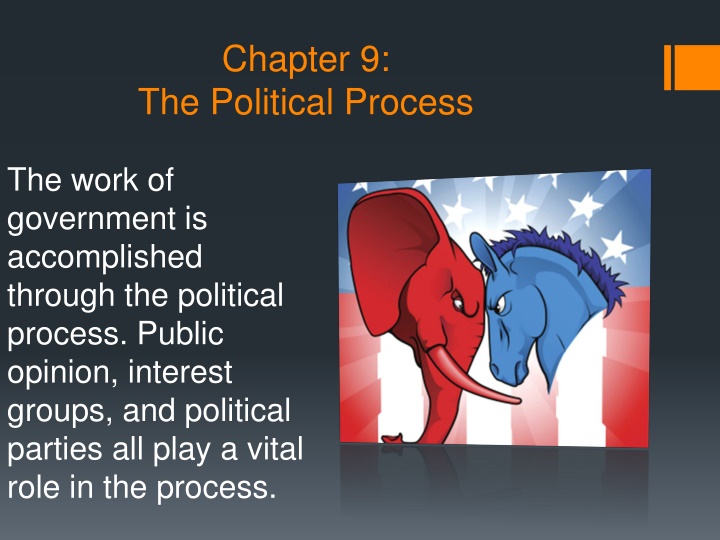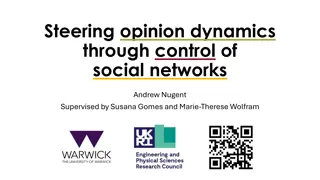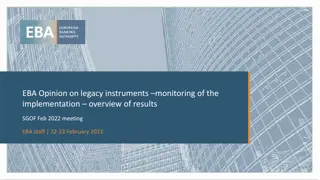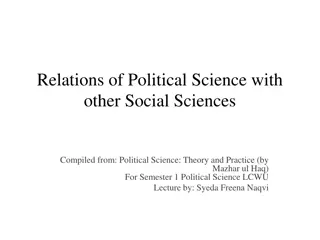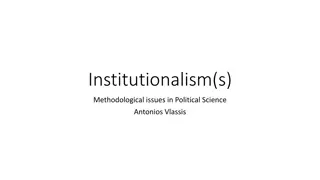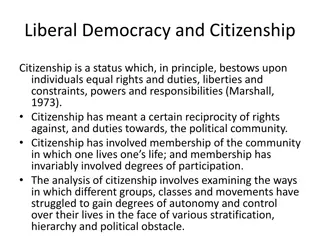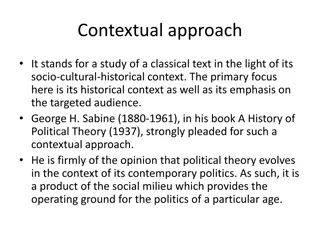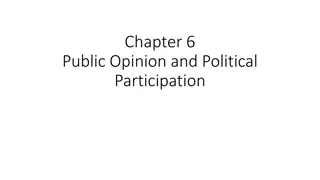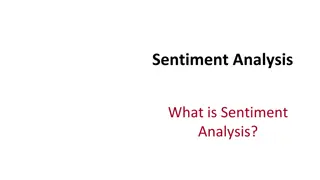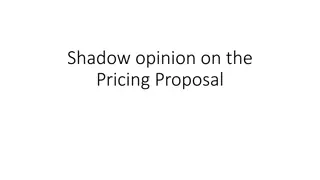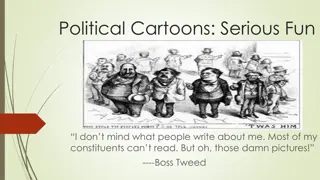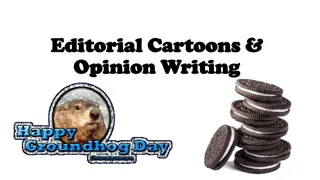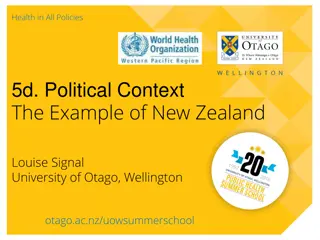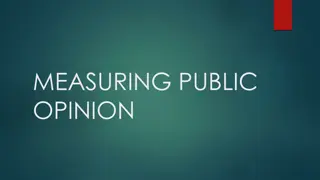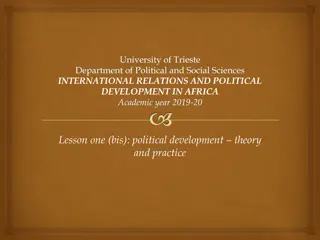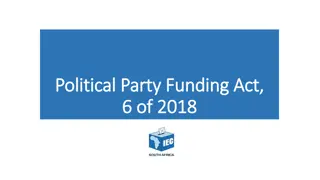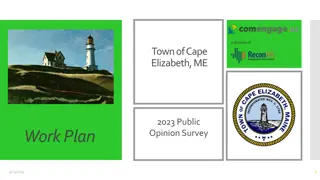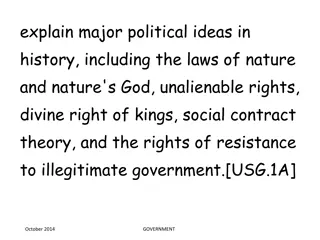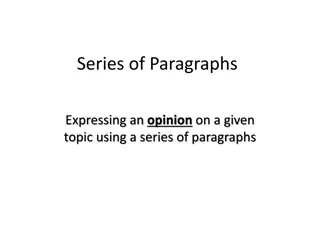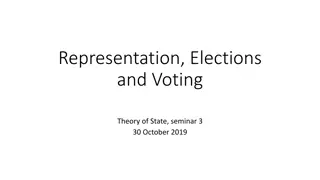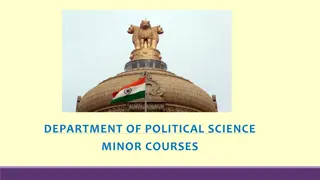The Role of Public Opinion in the Political Process
The political process involves the interaction of public opinion, interest groups, and political parties. Public opinion, shaped by factors like media and socialization, influences government actions. This chapter discusses the significance of public opinion, its formation, and measurement through polls. Partner projects focus on creating public opinion polls, while media's impact on public opinion and criticism are also explored.
Download Presentation

Please find below an Image/Link to download the presentation.
The content on the website is provided AS IS for your information and personal use only. It may not be sold, licensed, or shared on other websites without obtaining consent from the author.If you encounter any issues during the download, it is possible that the publisher has removed the file from their server.
You are allowed to download the files provided on this website for personal or commercial use, subject to the condition that they are used lawfully. All files are the property of their respective owners.
The content on the website is provided AS IS for your information and personal use only. It may not be sold, licensed, or shared on other websites without obtaining consent from the author.
E N D
Presentation Transcript
Chapter 9: The Political Process The work of government is accomplished through the political process. Public opinion, interest groups, and political parties all play a vital role in the process.
Section 1: Public Opinion Public opinion is the collection of views that people hold on public issues. Public opinion is important because it often influences the political process and affects the actions the government takes.
Do Now Why do you think public opinion is so important to our government?
Learning Goals Essential Question Objectives Describe public opinion. Describe how public opinion is formed. Analyze how the media affects public opinion. Explain how public opinion is measured. What is the electoral process established by the Constitution, and how can citizens affect it?
I. What is Public Opinion? A. Public Opinion: Combined views of a segment of society on an issue. B. Public Policy: Choices the gov t. makes and its actions in response to an issue. C. Expressing Public Opinion i. Letters, blogs, protests, interest groups, voting D. Political Socialization: Process by which people acquire political beliefs. i. Family ii. School & Work iii. Other Personal Factors: Age, race, gender, religion, etc.
Partner Project 1. You will work with a partner to create a public opinion poll. 1. You need to create 5 questions relevant to our discussions in government class. 2. Go around the class and ask our sample your question. 3. Tally up your results 3. Create a Pie Chart and a Bar Chart with your results.
II. Media & Public Opinion i. Mass Media Yellow Journalism ii. Roles of Media i. Choosing issues, issues or interest stories iii. Criticism of Media i. Bias: Errors introduced into polling to favor an outcome. ii. Factual Inaccuracy: Careless about correct facts. iii. Media Consolidation: All news owned by a few companies. iv. Future of Media i. Propaganda: Statements meant to influence public opinion. i.
III. Measuring Public Opinion A. Poll: A survey of people scientifically selected to provide opinions. B. Sample: Group of people who take part in the poll. C. Sampling Error: Indicates a poll s accuracy. D. Objectivity: Freedom from bias and outside influences. E. Exit Poll: Randomly selected fraction of voters after they have voted.
9-1: Exit Slip 1.Body of ideas shared by a segment of society on issues of interest or concern. 2.Process by which people acquire political beliefs. 3.Statements meant to influence public opinion or promote a cause or viewpoint. 4.Group of people who take part in a poll. 5.Freedom from bias and outside factors.
Section 2: Interest Groups Interest groups are private organizations that try to influence public opinion and convince public officials to accept their goals and views. They give political power to segments of society that have similar views.
Do Now What is the most important issue to you and why? (Example: Abortion, Terrorism, Education)
Learning Goals Essential Question Objectives Explain what interest groups are, and what role they play in the political process. Describe what different types of interest groups exist. Describe how interest groups work. Analyze whether interest groups serve the public good. How do interest groups influence elections?
I. Interest Groups & what they Do A. Special Interest Group: Association of people who hold similar views. B. Political Action Committee (PACs): Organization to raise money for candidates C. Organizing Interests: Anyone can start one. D. Encourage Participation in politics E. Supplying Info to voters and politicians
Activity: Part 1 You and your partner will be creating your own Interest Group. Identify a shared interest and define what position you want to take on that topic.
II. Types of Interest Groups A. Agricultural Groups: Farm bureau, potato Council B. Business Groups: Chamber of Commerce, Snack Food Association C. Labor Groups: Unions D. Cause-Based Groups: PETA, MADD, E. Societal Groups: Organization for Women, AARP F. Professional Groups: AMA, AMBA
Activity: Part 2 Decide how you are going to engage in the political process. Do you want to write a letter, conduct a survey, create a public opinion poll about your topic? List main ideas for your letter or create questions for your survey/poll.
III. Functions of Interest Groups A. Endorsing Candidates: Publicly declare support. B. Lobbying: To persuade a public official to vote your way. C. Informing Public Opinion: Grassroots means to talk to individuals one at a time. D. Filing Lawsuits: Brown v. Board of Edu. E. Benefits: Gives strength to individuals usually ignored. F. Criticisms: Too much influence w/ money and only serving limited wants.
Activity: Part 3 Write your letter to your member of Congress. Conduct your poll/survey with your sample .
Exit Slip 1. What are interest groups? 2. Interest groups use political action committees to ________________. 3. What type of interest group is Mothers Against Drunk Driving (MADD)? 4. The practice of interest groups contacting public officials to persuade them to support the groups positions is known as_____________________. 5. What prompted Congress to pass legislation in 2007 that placed limits on some types of interest group activity?
Section 3: Political Parties Political Parties are formal organizations that work to elect candidates to public office. Our political system is dominated by two major parties, but other parties are actively involved in the system.
Do Now Which political party do you think you would be most likely to vote for and explain why you feel compelled to vote for that party.
Learning Goals Objectives Essential Question Describe political parties and what role they play in the political process. Explain how the two-party political system works. Analyze how political parties are organized. Explain how political parties serve the public good. What is the main purpose of a political party at all levels of its organization?
I. The Role of Political Parties A. Political Party: Organization that tries to elect its members to public office. B. Political Spectrum: Continuum of social and political beliefs. C. 3 Main Roles i. Nomination Process: Naming a candidate for elective office. ii. Electoral Process: Issues, brand name, help electorate register to vote, hold politicians accountable. iii. Run Government: Majority party chooses who runs the Congress, and President appoints people.
Activity: Part 1 You will be creating your own political party. Will you be conservative or liberal or in-between? Create a name & Symbol.
II. American Two-Party System A. Party Systems i. One-party system: 1 party controls gov t. ii. Two-party system: 2 parties compete to control gov t. iii. Multiparty system: Several parties compete for control (Most common around the world). B. American Political Parties i. Third Party: Any party that isn t one of the major two political parties. ii. Independent Candidates: Candidate not associated with any party.
Activity: Part 2 You will need to create a platform for these areas: Taxes Military Spending & use Education Abortion Gay Marriage Gun Control National Debt/ Deficit Morality Immigration Terrorism Health Care School Lunches
III. Party Organization & Critics A. Local parties i. Precinct: Smallest unit for local voting. ii. Ward: Voting district made up of several precincts. B. State parties: Support & try to elect local, state, & national candidates. C. National Parties: Committees for fund- raising, supporting campaigns, & attracting voters. D. Benefits: Filters out extremes, Broad base of supporters. E. Criticisms: Lack loyalty, personal success than nat l. success, partisan.
1. The body of people entitled to vote. 2. A system of choosing candidates to run for elective office. 3. A voting district made up of several precincts. 4. An organization that tries to get its members elected to public office so that its views shape public policy. 5. The smallest unit for administering elections and local voting. 6. Any political party in a two-party system other than the two major ones.
Section 4: The Electoral Process The Constitution creates a system in which citizens elect representatives to public office. Each citizen has the responsibility to help make this system work. Citizens can affect the electoral process in many ways, but the most powerful is by voting on election day.
Do Now What is the issue that you feel strongly enough about to decide who you would vote for? Explain why you feel that way about the issue. Which party do you think supports your feelings on that issue?
Learning Goals Objectives Describe how a political campaign is organized and financed. Explain how candidates are chosen for an election. Analyze the four factors that may influence voting and voting behavior. Explain how political campaigns serve the public good. Essential Question What are the two basic requirements a person must meet to be eligible to vote?
I. Financing Campaigns & Nominations A. Financing Campaigns i. Hard Money: Money donated to an individual campaign. ii. Soft Money: Money given to a party, rather than a candidate. B. Choosing Candidates Write-in Candidates: Announce they re running but voters have to write their name into ballot. Caucus: Meeting of party members to choose candidate. Direct Primary: Party candidate chosen by voters. Closed Primary: Only registered party members vote. Open Primary: Any registered voter can vote for candidate.
II. Voting & Voter Behavior A. Voter Turnout i. 66% of Americans vote for Prez. ii. 40% in non-prez elections. B. Voting Requirements. i. U.S. Citizen & 18 yrs. Old ii. Resident of state you re voting in. C. Voter Behavior (4 Factors) i. Party identification ii. Issues iii. Candidate s background iv. Voter s background
III. More about Elections A. Plurality: Candidate with more votes than anyone else. B. Federal Elections i. 1stTuesday following 1stMonday in Nov. on even years. ii. Absentee Ballot: Ballot submitted on or before election day by someone that cannot be present election day. C. Elections & Public Good i. Express your opinion on how the country should be run. ii. Campaigns give out lots of info to voters. D. Criticisms i. 30 second commercials not reliable & misleading. ii. Negative ads keep voters away.
1. State and federal laws regulate how much ____, or money donated to an individual campaign, people can donate to a political candidate. 2. _______ is money given to a party, rather than to a candidate. 3. One of the most famous ___________ for president was Eugene V. Debs, a leader of the Socialist Party. 4. In some states, candidates for election are chosen by a meeting of party members called a(n) ____________________. 5. In a direct _____________________, the party s candidate for office is chosen directly by voters.
